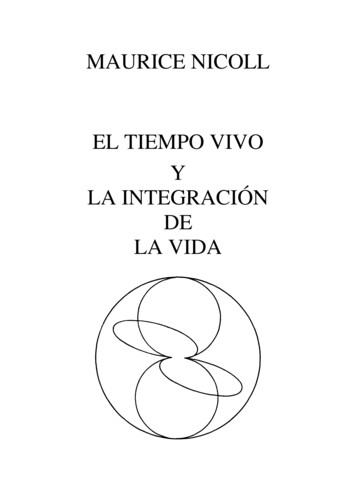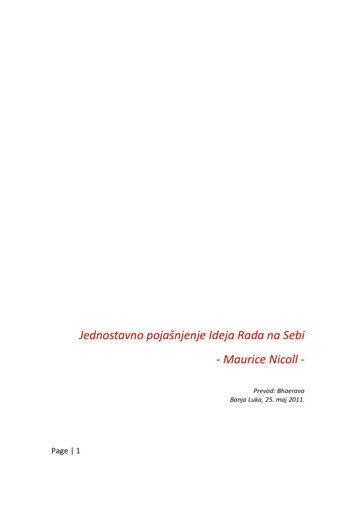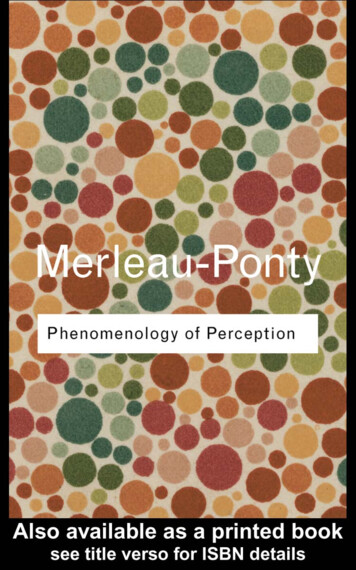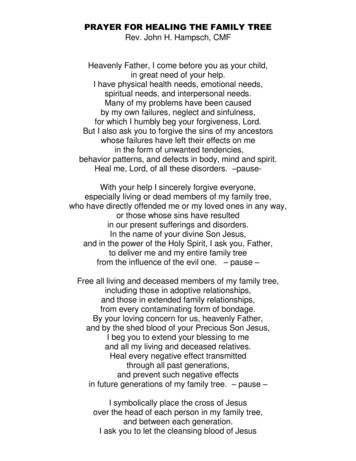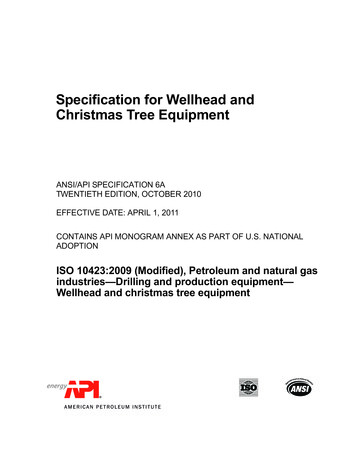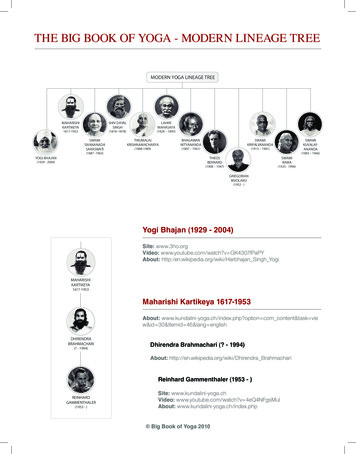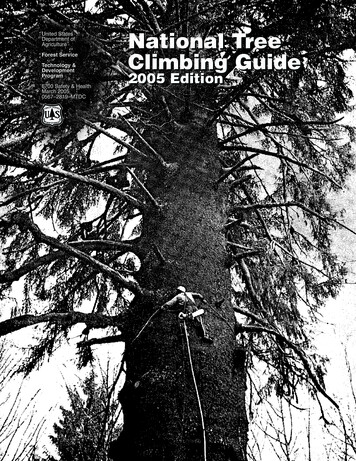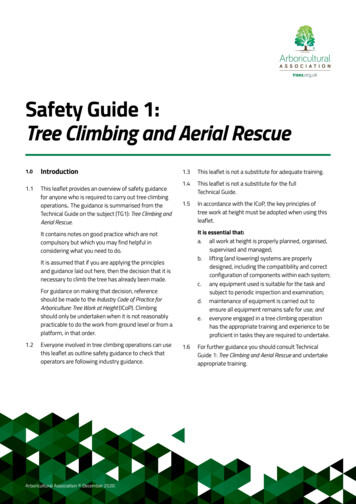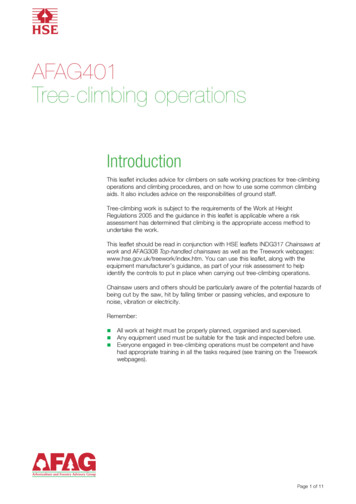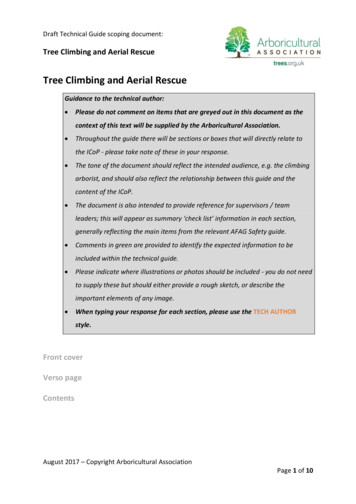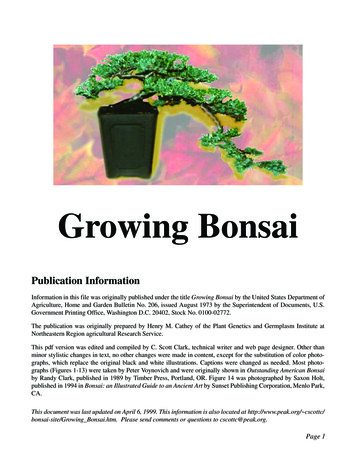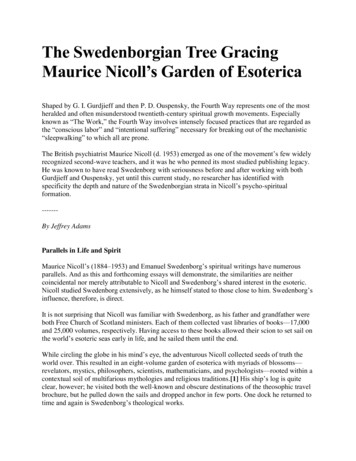
Transcription
The Swedenborgian Tree GracingMaurice Nicoll’s Garden of EsotericaShaped by G. I. Gurdjieff and then P. D. Ouspensky, the Fourth Way represents one of the mostheralded and often misunderstood twentieth-century spiritual growth movements. Especiallyknown as “The Work,” the Fourth Way involves intensely focused practices that are regarded asthe “conscious labor” and “intentional suffering” necessary for breaking out of the mechanistic“sleepwalking” to which all are prone.The British psychiatrist Maurice Nicoll (d. 1953) emerged as one of the movement’s few widelyrecognized second-wave teachers, and it was he who penned its most studied publishing legacy.He was known to have read Swedenborg with seriousness before and after working with bothGurdjieff and Ouspensky, yet until this current study, no researcher has identified withspecificity the depth and nature of the Swedenborgian strata in Nicoll’s psycho-spiritualformation.------By Jeffrey AdamsParallels in Life and SpiritMaurice Nicoll’s (1884–1953) and Emanuel Swedenborg’s spiritual writings have numerousparallels. And as this and forthcoming essays will demonstrate, the similarities are neithercoincidental nor merely attributable to Nicoll and Swedenborg’s shared interest in the esoteric.Nicoll studied Swedenborg extensively, as he himself stated to those close to him. Swedenborg’sinfluence, therefore, is direct.It is not surprising that Nicoll was familiar with Swedenborg, as his father and grandfather wereboth Free Church of Scotland ministers. Each of them collected vast libraries of books—17,000and 25,000 volumes, respectively. Having access to these books allowed their scion to set sail onthe world’s esoteric seas early in life, and he sailed them until the end.While circling the globe in his mind’s eye, the adventurous Nicoll collected seeds of truth theworld over. This resulted in an eight-volume garden of esoterica with myriads of blossoms—revelators, mystics, philosophers, scientists, mathematicians, and psychologists—rooted within acontextual soil of multifarious mythologies and religious traditions.[1] His ship’s log is quiteclear, however; he visited both the well-known and obscure destinations of the theosophic travelbrochure, but he pulled down the sails and dropped anchor in few ports. One dock he returned totime and again is Swedenborg’s theological works.
My research moors Nicoll to Swedenborg’s dock in two principal stages. The first stage occursamidst no fewer than thirteen other spiritual traditions. Perhaps because of this maelstrom, itappears that he did not find Swedenborg—nor any system of thought, for that matter—satisfactory. He continued his search far and wide until 1921 when at the age of thirty-seven hereturned from a lecture by G. I. Gurdjieff’s protégé, P. D. Ouspensky, and declared to his wifeand fellow seeker, Catherine, “This is it.”[2] The treasure had not been found, of course, but theyhad finally discovered their treasure map.[3]After decades of searching, Nicoll christened his well-traveled ship the Fourth Way.[4] He andCatherine would be at its helm teaching Gurdjieff’s fusion of Eastern and Western spiritualitiesfor the rest of their lives.[5] A year before his death, Nicoll listed the mystical travels he hadtaken prior to meeting Ouspensky and Gurdjieff:Now I had already studied at different times in the past the Gnostic literature, the NeoPlatonists, the Alchemists, some of the Indian Scriptures, the Hermetic writers, the Sufiliterature, the Bible, the Chinese Mystics, the writings of Eckhart, Boehme, Blake,Swedenborg and others, and had been a pupil of Jung for some years.[6]It is little wonder, then, why the Academy remains unaware of Swedenborg’s influence uponNicoll. Despite Nicoll’s intense focus upon his systematic theology, Swedenborg is listed almostas an afterthought.An intense one-year immersion (November 4, 1922–October 1923) at Gurdjieff’s “Institute forthe Harmonious Development of Man” outside Paris, followed by a close friendship andmentoring with Ouspensky for an additional eight, led to the request that Nicoll assume the roleof an independent Fourth Way teacher in 1931. Historical records demonstrate a secondSwedenborgian stage that began prior to 1940. Now in his fifties, Nicoll’s focus narrowed to four“indispensable” systems that were supplemental to the Fourth Way: the Bible, “all the volumesof Swedenborg,” Hermeticism, and Platonism.[7] It was during this final stage that he composedhis eight-volume esoteric garden, which consisted of four titles.[8] Swedenborg’s influence isapparent through all of them but most especially in his exegetical works The New Man and TheMark.The parallels between Nicoll and Swedenborg do not stop with their writings. Their livesdemonstrate uncanny similarities. Both were sons of domineering ministerial fathers; wereafflicted with a stutter; began as scientists, found the paradigm wanting, and became rationalmystics; experienced the horrors of war; immersed themselves in new fields of study; wereinsiders with their country’s leadership; traveled Western Europe on academic research trips;published anonymously or used a pseudonym; lived in London for long periods; studied andrecorded their dreams; began as Protestants; kept diaries; had numerous siblings; lost theirmothers as children; were the apple of their step-mother’s eye; were wealthy; were pragmaticdespite being polymathic; played instruments; wrote poetry; drank alcohol in moderation; and byall accounts were downright convivial and pleasant gentlemen.[9] Unfortunately, though, theywere also similar in another fundamental manner. Despite being two of the most rational writersabout the irrational process of transforming the heart, they remain relativelyunknown.[10] Swedenborg has rallied of late;[11] but Nicoll remains unrecognized, despite his
studies with such renowned figures as Jung, Ouspensky, and Gurdjieff and despite his being oneof the most well-informed and astute explorers of the psychic seas. Like Swedenborg before him,Nicoll does not fit neatly into previously existing star charts. As with the hypothesized darkmatter of astrophysics, their influence remains a relatively unseen element in the contemporaryesoteric universe.A New Church GardenAfter his worldwide journey, Nicoll returned home and planted his global collection of esotericseeds within the rich soil of the heart-logic for which he was celebrated.[12] His extensivespiritual garden grew thick and lush, but its most dominant feature is the glimmering foliage andlush fruit on the heaven-bound tree towering at its center. The thesis guiding this researchpostulates that the systematic theology of our favorite Scandinavian scientist-seer is theunderground stream of wisdom feeding the deep roots of both this Hyperion-like tree and itssurrounding hermeneutical garden.[13]The fruit of Nicoll’s allegorical garden was initially private, for Fourth Way eyes and ears only.This circumstance stemmed from Gurdjieff’s belief that his system would not be efficacious inthe hands of the desperate, merely curious, or academic-minded—that it would, in fact, do themharm. Only when faced with imminent death did Gurdjieff accept the risk of sharing his systemmore broadly. Like the Word’s representative style and, some would argue, the sheer volume ofSwedenborg’s theological corpus, various characteristics, such as the purposefully convolutedstoryline of Beelzebub’s Tales to His Grandson, the broad distribution of Work principlesthroughout a variety of volumes, and the overall indecipherability of the ideas without havingaccess to the oral tradition held by Fourth Way teachers, protected the Work’s wisdom fromthose who might profane it. As did other Fourth Way teachers of his era, Nicoll either agreedwith Gurdjieff or was following his lead out of respect for the man to whom he attributes hischange of being.[14]Beginning in 1949, the year of Gurdjieff’s death, the market was flooded by a backlog of FourthWay publications that would become esoteric classics of the twentieth century. Ouspensky’s InSearch of the Miraculous (1949) led the way.[15] This was immediately followed by Gurdjieff’smagnum opus, Beelzebub’s Tales to His Grandson (1950), which, if the Fourth Way could besaid to have a sacred scripture, would be considered just that. Regardless, the literary scholarMartin Seymour-Smith deems it one of the hundred most influential books of all time.[16]Throughout the 50s, however, Nicoll’s titles predominated the scene. His “simple and clearexplanations in easily comprehensible language,” as one Swedenborgian describes them, arewell-suited for a general audience.[17] In fact, Swedenborgians familiar with Nicoll’s worksconsistently cite this characteristic as the principal justification for their use.[18]In addition to being drawn to Nicoll’s effortless writing style, Swedenborgians are likelyattracted to Nicoll for another of his characteristics. Unlike his fellow Fourth Way teachers,Nicoll is openly Christ-centric, a feature that is most prominent in his first publication, The NewMan: An Interpretation of Some Parables and Miracles of Christ (1950). Despite never once
mentioning Swedenborg by name, its focus upon the Lord makes its exegesis Nicoll’s mosthermeneutically Swedenborgian. These “new” explanations of the meaning of Christ’s life arenot as new as Nicoll’s non-Swedenborgian readers may believe, but they may explain why itappears that many Swedenborgians are drawn to the Fourth Way through Nicoll instead ofthrough either Ouspensky or Gurdjieff.[19] Such was the case with Urbana College professorand long-time editor of The Messenger, Rev. Dr. Bjorn Johannson, who may have been the firstSwedenborgian to publicly recognize the Fourth Way by means of Nicoll’s use of Swedenborgin The New Man. Johannson immediately recognized that Nicoll appears to have been using theWritings’ systematic theology generally and the science of correspondencesspecifically.[20] What he and others have not mentioned, however, is that Nicoll used theWritings in a manner few Swedenborgian officials have dared.As anyone familiar with Searle’s Index of Swedenborg’s Scripture Quotations can attest, only 55of its 321 pages (17%) are Gospel references.[21] It is a curiosity of Swedenborgianism that theleast obvious Christ-centric storylines of the Scriptures are used so disproportionately to expounda new Christianity. Perhaps it is self-evident to some why this is so, but it could be argued thatthis approach may have led to an unspoken thirst to have Swedenborg’s hermeneuticalmethodology applied to the Gospels more fully. Nicoll certainly quenches our thirst with theliving water of the Gospel-focused The New Man and its sequel, the posthumously published TheMark(1954). They are easily Nicoll’s most obviously Swedenborgian works.Swedenborgians’ discovery of Nicoll’s esoteric works led to their making basic inquiries andcasual theories for more than half a century. Initial forays, however, were fairly inconclusive andled to more questions than answers. Likely due to the fact that biographical materials on FourthWay teachers had not yet surfaced at the time, Swedenborgians were flying blind for almost adecade (e.g., Nicoll’s assistant and official biographer, Beryl Pogson, did not publish MauriceNicoll: A Portrait until 1961). They could see the influence, but they were unable to prove it,much less explain Nicoll’s surreptitiousness. The goal of this research, therefore, is to both sharethe quest of organizing what research does exist and uncover additional details pointing towardconnections so that the truth about this often misunderstood and ‘secret’ Swedenborgian comesto light.Nicoll is mysteriously elusive in written works, only mentioning Swedenborg’s name in passing;and this is what is most consistently noted in Swedenborgian reception history of his allegoresis.Accounts often begin with the sense of exuberant excitement so often accompanying thediscovery of Swedenborg’s poetic hermeneutic—the counterintuitively labeled “science ofcorrespondences”—but the ideal of angelic forbearance and assumption of positive intent are aselusive as they are rare, so an indignant perturbation demanding credit to Swedenborg oftenfollowed.[22]What seems less familiar, then, is the broader context of Nicoll’s relationship with Swedenborg’sworks. Consider the reliable account that when Nicoll retrieved and initialed the tome DivineLove and Wisdom from his library for an adherent running out the door to defend Britannia inHer Majesty’s Royal Navy, the seaman records that although he “finds it easy to reach saturationwith that author, Dr. Nicoll was wont to quote from him frequently.”[23]
Regular verbal recognition with his students but almost no textual referencing, however, is asperplexing as it is uncharacteristic of Nicoll’s garden of esoterica. His referencing style generallytakes after the gardens of his British heritage by sourcing outside spiritualities to the point wherefor some tastes it could be considered overcrowded, à la the revelators, mystics, et al., notedearlier.It is safe to conclude, therefore, that “quote from him frequently” refers to his private lecturesand responses during the Socratic discussions that are so characteristic of Fourth Way groupmeetings. Nicoll’s “frequent” naming of Swedenborg certainly did not occur in text. The meresixteen mentions of his name throughout Nicoll’s corpus find thirteen of them in one workalone, Living Time, his oldest and most philosophical work.[24] Neither did he circumvent thename Swedenborg by using the titles of the Writings themselves. Such references are even rarer.Only one, Arcana Coelestia, is listed—along with its publisher, the Swedenborg Society, locatedin his hometown of London—and that, too, in Living Time (in the bibliography, to beprecise).[25]While it was clearly not Nicoll’s intent to carelessly plagiarize Swedenborg or seek to present hisf
Maurice Nicoll’s (1884–1953) and Emanuel Swedenborg’s spiritual writings have numerous parallels. And as this and forthcoming essays will demonstrate, the similarities are neither coincidental nor merely attributable to Nicoll and Swedenborg’s shared interest in the esoteric. Nicoll studied Swedenborg extensively, as he himself stated to those close to him. Swedenborg’s influence .
